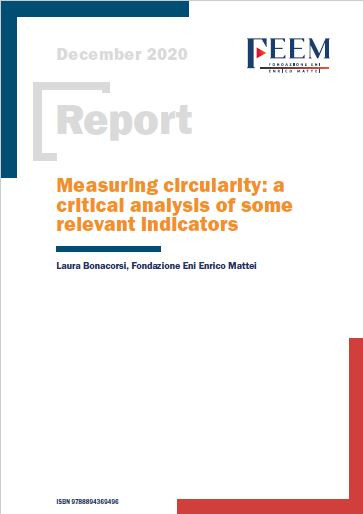Measuring circularity: a critical analysis of some relevant indicators
The concept of Circular Economy has become of great importance in the last decade, and this trend is likely to strengthen in the EU in the years to come. In fact, the European recovery strategy from the Covid-19 sanitary emergency is based on the EU Green Deal, which is in turn deeply connected to the New Circular Economy Action Plan adopted by the Commission in March 2020. Timmermans, the Executive Vice-president for the Green Deal, stated that “to achieve climate-neutrality by 2050, to preserve our natural environment, and to strengthen our economic competitiveness, requires a fully circular economy” . In order to achieve this goal, it becomes an absolute necessity to measure circularity at different levels: geographical areas, such as cities and regions, as well as narrower entities such as economic sectors, companies and even at the product-level. A “metric system” for circularity would allow describing the current situation, evaluating possible future achievements and hence directing policy interventions towards regions or sectors more in need.
This report’s aim is to shed light on this issue, providing a critical review of some of the existing indicators measuring the circular economy. This will not be a comprehensive review: many papers, such as Saidani et al. (2019), have already filled in the gap in the literature by providing original taxonomies for the classification of the circular economy indicators. In what follows, we will instead analyse some of the most relevant and more recently introduced indicators, sometimes reporting the formulas needed for their computation, in order for the interested reader to get a broad picture of how these indicators are constructed, of their main advantages and shortcomings. Future research will provide a new synthetic indicator, or at least a small set of measures, based on the existing literature; it will be more synthetic, comprehensive and directly employable by policymakers, company representative, as well as academics.
The concept of Circular Economy has become of great importance in the last decade, and this trend is likely to strengthen in the EU in the years to come. In fact, the European recovery strategy from the Covid-19 sanitary emergency is based on the EU Green Deal, which is in turn deeply connected to the New Circular Economy Action Plan adopted by the Commission in March 2020. Timmermans, the Executive Vice-president for the Green Deal, stated that “to achieve climate-neutrality by 2050, to preserve our natural environment, and to strengthen our economic competitiveness, requires a fully circular economy”. In order to achieve this goal, it becomes an absolute necessity to measure circularity at different levels: geographical areas, such as cities and regions, as well as narrower entities such as economic sectors, companies and even at the product-level. A “metric system” for circularity would allow describing the current situation, evaluating possible future achievements and hence directing policy interventions towards regions or sectors more in need.
This report’s aim is to shed light on this issue, providing a critical review of some of the existing indicators measuring the circular economy. This will not be a comprehensive review: many papers, such as Saidani et al. (2019), have already filled in the gap in the literature by providing original taxonomies for the classification of the circular economy indicators. In what follows, we will instead analyse some of the most relevant and more recently introduced indicators, sometimes reporting the formulas needed for their computation, in order for the interested reader to get a broad picture of how these indicators are constructed, of their main advantages and shortcomings. Future research will provide a new synthetic indicator, or at least a small set of measures, based on the existing literature; it will be more synthetic, comprehensive and directly employable by policymakers, company representative, as well as academics.

